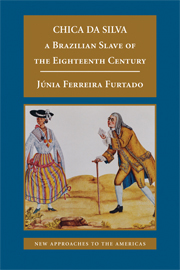Book contents
- Frontmatter
- Contents
- Acknowledgments
- Preface
- Maps
- Introduction to the English Edition
- 1 Land of Stars
- 2 Chica da Silva
- 3 The Diamond Contractors
- 4 Black Diamond
- 5 The Lady of Tejuco
- 6 Life in the Village
- 7 Mines of Splendor
- 8 Separation
- 9 Disputes
- 10 Destinies
- 11 Chica-que-manda
- Abbreviations
- Suggested Reading
- Index
- Plate section
11 - Chica-que-manda
Published online by Cambridge University Press: 05 September 2014
- Frontmatter
- Contents
- Acknowledgments
- Preface
- Maps
- Introduction to the English Edition
- 1 Land of Stars
- 2 Chica da Silva
- 3 The Diamond Contractors
- 4 Black Diamond
- 5 The Lady of Tejuco
- 6 Life in the Village
- 7 Mines of Splendor
- 8 Separation
- 9 Disputes
- 10 Destinies
- 11 Chica-que-manda
- Abbreviations
- Suggested Reading
- Index
- Plate section
Summary
Swirl the night, swirl,
golden sifter
of Chica da Silva,
of Chica-que-manda.
HISTORICAL MEMORY
In 1853, Joaquim Felício dos Santos, a lawyer from Diamantina, was appointed attorney on the amicable division of assets that followed the divorce of Lieutenant Feliciano Atanásio dos Santos, the lawyer's uncle, and Frutuosa Batista de Oliveira, Francisca da Silva de Oliveira's granddaughter. Seven years later, Chica's heirs appointed this same lawyer as their attorney on a lawsuit demanding possession of the Brazilian assets of Chief Judge João Fernandes de Oliveira.
These legal proceedings provided him with an unusual source of material from which to compose his colonial chronicles, as in his spare time Joaquim Felício compiled a history of the region, which he published in chapters between 1862 and 1864 in the local newspaper, O Jequitinhonha. After all, here was a family descended from slaves, heirs to a vast patrimony that included farms, a considerable number of slaves, urban properties, and various nonfixed assets. As he had access to all the documents relevant to his case in the dispute over the diamond contractor's assets, the lawyer was able to include in his chronicle a transcription of the will in which João Fernandes meticulously listed his various properties in Portugal, Rio de Janeiro, and Minas Gerais.
It was in the pages of O Jequitinhonha, and later in book form under the title Memórias do Distrito Diamantino, published in 1868, that Chica da Silva first emerged as an historical figure from the mists that erased and obscured the region's past.
- Type
- Chapter
- Information
- Chica da SilvaA Brazilian Slave of the Eighteenth Century, pp. 284 - 304Publisher: Cambridge University PressPrint publication year: 2008



